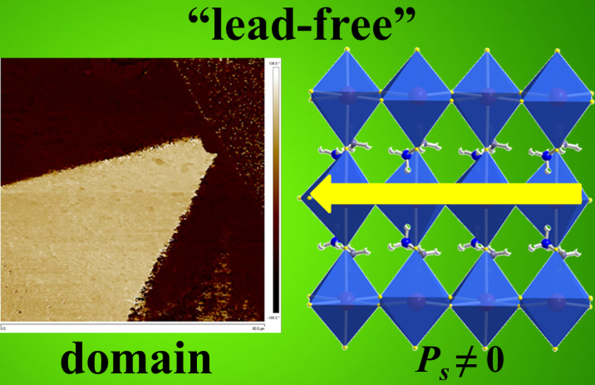Ferroelectricity in semiconductor materials continues to gain interest for potential applications in smart sensors, energy harvesters, human interfaces, and self-powered photoelectric devices. Recently, the ferroelectricity in organic-inorganic hybrid perovskites gained researchers’ attention owing to their prominent carrier transport properties, instinctively tunable photoresponse, and solution processability.
As  expected, a series of two-dimensional (2D) layered hybrid perovskite ferroelectrics have been successfully synthesized and prominent photoelectric properties were acquired. Nevertheless, these ferroelectrics contain high concentrations of toxic Pb which threaten the human body and biological systems a potential stumbling block for their further application.
expected, a series of two-dimensional (2D) layered hybrid perovskite ferroelectrics have been successfully synthesized and prominent photoelectric properties were acquired. Nevertheless, these ferroelectrics contain high concentrations of toxic Pb which threaten the human body and biological systems a potential stumbling block for their further application.
In a study published in J. Am. Chem. Soc., a research group led by Prof. LUO Junhua from Fujian Institute of Research on the Structure of Matter of Chinese Academy of Sciences, reported a potential lead-free  hybrid perovskite ferroelectric semiconductor: (C4H9NH3)2(NH3CH3)2Sn3Br10.
hybrid perovskite ferroelectric semiconductor: (C4H9NH3)2(NH3CH3)2Sn3Br10.
The researchers found that this Sn-based hybrid perovskite undergoes a characteristic ferroelectric phase transition around 318 K with a relatively large spontaneous polarization of 11.76 μC cm-2. Mechanistic studies reveal that such ferroelectricity can be attributable to the synergistic effects of ordering of organic cations and stereochemically active lone-pair electrons inducing distortion of inorganic octahedral.
Besides, temperature-dependent domain evolutions observed via polarized light microscopy and piezoresponse force microscopy measurements confirm the biaxial characteristic of (C4H9NH3)2(NH3CH3)2Sn3Br10, according to that of structure change.
This is the first example of a Sn-based hybrid perovskite semiconductor featuring ferroelectric performance.This study offers an efficient approach for exploring “green” ferroelectric semiconductors with potentially enhanced energy conversion efficiency.

Schematic illustration of (C4H9NH3)2(NH3CH3)2Sn3Br10 with PFM domain signals (Image by Prof. LUO’s group)
Contact:
Prof. LUO Junhua
Fujian Institute of Research on the Structure of Matter
Chinese Academy of Sciences
Email: jhluo@fjirsm.ac.cn